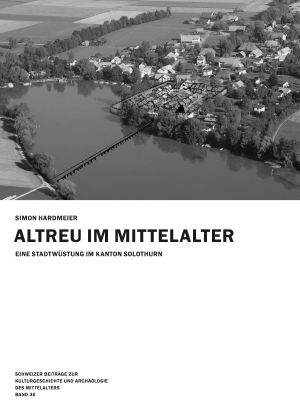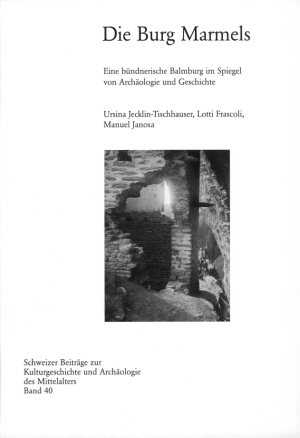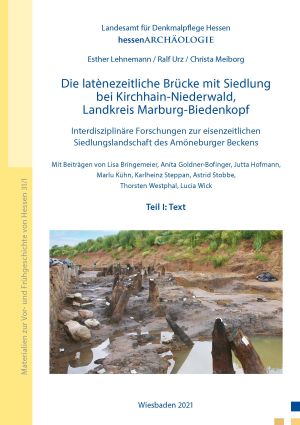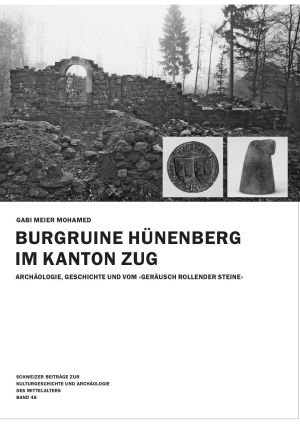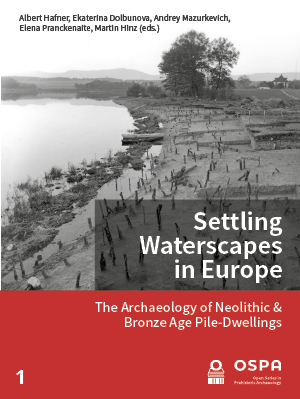Kühn, Marlu
Eine Stadtwüstung im Kanton Solothurn: Altreu im Mittelalter
At Altreu, a hamlet in the municipality of Seuzach on the River Aare, it was its proximity to the river that caused the archaeological substance to disappear. Since 1949, partial features of a settlement have come to light in numerous construction pits. The publication has assembled these sections to form an overall picture, which is of great importance, both for medieval research in Canton Solothurn and for the archaeology of the Middle Ages in the whole of Switzerland. Thanks to the fact that much has been preserved in a coherent overall picture that elsewhere has to be painstakingly reconstructed from isolated fragments, the study provides invaluable insight into what life was like in a small medieval town. With fortification walls, a citadel and residential buildings facing onto the alleyways, Altreu had all the elements typically associated with a medieval town. Following a conflagration in the second half of the 14th century, the town was abandoned and subsequently forgotten. A considerable legacy, however, has survived in the ground: more than 20,000 artefacts were retrieved and are presented in an extensive catalogue sorted by category.
Die Burg Marmels: Eine bündnerische Balmburg im Spiegel von Archäologie und Geschichte
The ruins of Marmels Castle are located some one hundred metres above the Marmorera reservoir, below a massive ledge (municipality of Marmorera situated in the Oberhalbstein/Sursés Valley in Canton Grisons). In the High and Late Middle Ages, the castle was in the hands of the Lords of Marmels, who were ministerials of the Bishop of Chur. The complex at this dizzy height once included a chapel with two adjacent buildings, a gateway building and a representative residential tower with at least four storeys.
As part of a comprehensive restoration of the castle ruins the Archaeological Services of Canton Grisons were able to carry out architectural surveying of the preserved building remains and excavations in the grounds in 1987 and 1988. An excavation being carried out in castle grounds is a rare occurrence in Canton Grisons. However, it was actually the findings from the excavations that were of particular significance for Swiss castle research.
Thanks to the location of the castle beneath a massive ledge, large parts of the complex had at all times been protected from the elements – a stroke of luck for researchers, since the finds were deposited in mostly dry conditions over the centuries. Apart from their large number, the variety and state of preservation of the finds was also extraordinary. Particularly the organic finds, which in medieval excavations usually only occur in small numbers, were numerous in Marmels: some 1,000 fragments of wood including utensils, furniture parts, architectural timbers and building waste were found in the excavated layers. Other finds included leather fragments and shoes, remnants of parchment, some of which bore writing, more than 21,000 animal bones and 18,000 individual plant remains. Besides the organic finds, the excavations also unearthed metal implements and innumerable fragments of slag, which attested to the production and working of metal, some pottery shards and a large assemblage of steatite vessels. Various wooden objects (architectural timbers and implements) yielded absolute dates by dendrochronological means.
This allowed us to date the construction of the castle to 1140 and its abandonment to the late 14th or early 15th century. Certain events from the castle’s history could also be dated using this method.
Die latènezeitliche Brücke mit Siedlung bei Kirchhain-Niederwald, Landkreis Marburg-Biedenkopf: Interdisziplinäre Forschungen zur eisenzeitlichen Siedlungslandschaft des Amöneburger Beckens
Between 2008 and 2012 hessenARCHÄOLOGIE uncovered a spectacular site of the later Iron Age in the northern Amöneburg Basin near Niederwald – the remains of a 21-metre-long wooden yoke-pile bridge that had served as a river crossing from around the middle of the 3rd to the middle of the 2nd century BC. It proved to be a stroke of luck that in 2011 400 m west of the bridge the remains of a contemporary settlement came to light, whose earliest traces date back to the Hallstatt period. The result of the in-depth interdisciplinary research, funded by the German Research Foundation (DFG), is a meticulous two-volume study that doesn’t just look at the local Iron Age remains, but draws a picture of the Amöneburg Basin during the 1st millennium BC in terms of landscape and settlement history.
Volume 2, s. hier.
Burgruine Hünenberg im Kanton Zug: Archäologie, Geschichte und vom «Geräusch rollender Steine»
A listed monument since 1962, the ruined castle at Hünenberg is one of the most important monuments of medieval cultural history in Canton Zug. The castle was built as early as 1100. Elaborately worked building blocks, colourfully painted exterior render and precious objects suggest that those who built it were members of the high nobility. The castle was later acquired by the Lords of Hünenberg, who over the course of the 13th and 14th centuries advanced their position to become one of the leading families of the minor nobility in the region. The most recent archaeological excavations, mounted over several short periods between 2005 and 2010, were the first to take advantage of modern scientific methods to examine a medieval castle site. The results of the analyses yielded surprising new insight into the castle’s history of construction and the lives of its former inhabitants.
Settling waterscapes in Europe: The archaeology of Neolithic and Bronze Age pile-dwellings
Pile dwellings have been explored all over Europe for decades now. This has led to the development of different methods and even schools of excavations and analysis techniques influenced by the research traditions in individual countries. This volume provides a current insight into international research on life in and around prehistoric waterscapes. It contains various case studies demonstrating the importance of scientific analysis for the study of settlement between land and water and on the anthropogenic influence on the landscapes around Neolithic and Bronze Age pile dwellings, presenting a new body of data and international perspectives on the settlement of European waterscapes.
Related research data are here.



